
Morchella esculenta is a species of fungus in the family Morchellaceae of the Ascomycota. It is one of the most readily recognized of all the edible mushrooms and highly sought after. Each fruit body begins as a tightly compressed, grayish sponge with lighter ridges, and expands to form a large yellowish sponge with large pits and ridges raised on a large white stem. The pitted yellow-brown caps measure 2–7 centimetres broad by 2–10 cm (1–4 in) tall, and are fused to the stem at its lower margin, forming a continuous hollow. The pits are rounded and irregularly arranged. The hollow stem is typically 2–9 cm long by 2–5 cm (1–2 in) thick, and white to yellow. The fungus fruits under hardwoods and conifers during a short period in the spring, depending on the weather, and is also associated with old orchards, woods and disturbed grounds.

Selenocosmia crassipes, synonym Phlogius crassipes, also known as the "Queensland whistling tarantula", "barking spider" or "bird-eating tarantula" is a species of tarantula native to the east coast of Queensland, Australia. The name "whistling tarantula" comes from its ability to produce a hissing noise when provoked, a trait it shares with other Australian theraphosids. This hissing is produced by the spider stridulating a patch of setae associated with its chelicerae. It has also been called the "eastern tarantula". The species name crassipes is Latin for "fat leg" referring to the relatively fat front legs.

Pontederia crassipes, commonly known as common water hyacinth, is an aquatic plant native to South America, naturalized throughout the world, and often invasive outside its native range. It is the sole species of the subgenus Oshunae within the genus Pontederia. Anecdotally, it is known as the "terror of Bengal" due to its invasive growth tendencies.
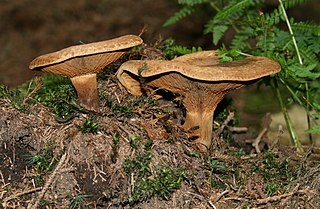
The Paxillaceae are a family of mushroom-forming fungi bearing close affinity to the boletes. Collectively, the family contains nine genera and 78 species. The type genus is Paxillus, containing fungi with decurrent gills, and Gyrodon, which has members with decurrent pores, among others. French mycologist René Maire had erected the family in 1902, placing it between the agarics and boletes and recognizing the groups' similarities with the latter group. Maire's usage of the name was later deemed to be invalid, and the genus authority is attributed to Johannes Paulus Lotsy. Molecular research confirms the relations of Gyrodon, with the decurrent-pored mushroom G. lividus, Paragyrodon, with the type species P. sphaerosporus, and Paxillus as sister groups, together lying near the base of a phylogenetic tree from which the genus Boletus arises. The name Gyrodontaceae, published by Belgian botanist Paul Heinemann in 1951, is considered synonymous with Paxillaceae.
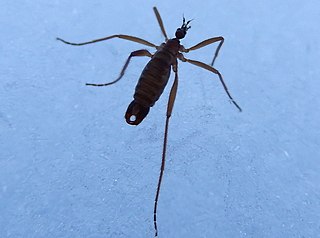
Chionea is a genus of wingless limoniid crane flies. It consists of two subgenera, the holarctic Chionea and palaearctic Sphaeconophilus. About 37 species are currently recognized in the northern hemisphere, but there are probably several undescribed species. They are commonly called snow flies.
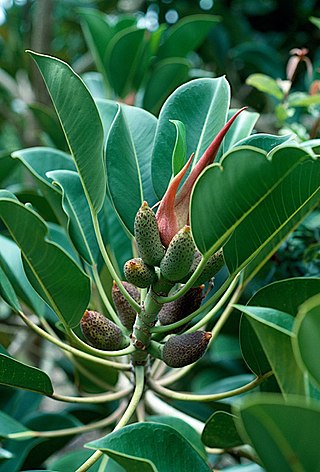
Ficus crassipes, commonly known as the round-leaved banana fig is a fig that is endemic to the wet tropical rainforests of northeastern Queensland, Australia. It has large brownish cylindrical syconia.
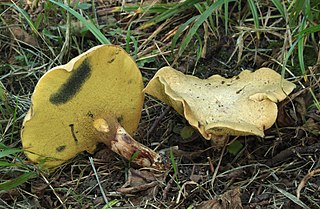
Gyrodon lividus, commonly known as the alder bolete, is a pored mushroom bearing close affinity to the genus Paxillus. Although found predominantly in Europe, where it grows in a mycorrhizal association with alder, it has also recorded from China, Japan and California. Fruit bodies are distinguished from other boletes by decurrent bright yellow pores that turn blue-grey on bruising. G. lividus mushrooms are edible.

Gyrodon is a genus of pored mushroom bearing close affinity to the genus Paxillus. Recent molecular research has confirmed this relationship of the two genera as sister taxa, together diverging as one of the most basal lineages in the Boletineae, and sister to the Boletaceae.

Pachygrapsus crassipes, the striped shore crab or lined shore crab, is a small crab found on both rocky and hard-mud soft seashores of the northeastern and northwestern Pacific Ocean. In North America, this species occurs from central Oregon, south through California to near Ensenada, Baja California, Mexico. There is an isolated population with a wide range disjunction at Bamfield on Vancouver Island, Canada. The western Pacific population, including both Korea and Japan is isolated with a divergence time from the eastern Pacific population estimated between 0.8 and 1.2 Mya.

Bothia is a fungal genus in the family Boletaceae. A monotypic genus, it contains the single species Bothia castanella, a bolete mushroom first described scientifically in 1900 from collections made in New Jersey. Found in the eastern United States, Costa Rica, China, and Taiwan, it grows in a mycorrhizal association with oak trees. Its fruit body is chestnut brown, the cap is smooth and dry, and the underside of the cap has radially elongated tubes. The spore deposit is yellow-brown. The edibility of the mushroom is unknown. Historically, its unique combination of morphological features resulted in the transfer of B. castanella to six different Boletaceae genera. Molecular phylogenetic analysis, published in 2007, demonstrated that the species was genetically unique enough to warrant placement in its own genus.
100 of the World's Worst Invasive Alien Species is a list of invasive species compiled in 2000 from the Global Invasive Species Database, a database of invasive species around the world. The database is run by the Invasive Species Specialist Group (ISSG) of the International Union for Conservation of Nature (IUCN). The ISSG acknowledges that it is "very difficult to identify 100 invasive species from around the world that really are 'worse' than any others. ... Absence from the list does not imply that a species poses a lesser threat." In 2013, the ISSG updated their list to supersede the recently eradicated † rinderpest virus, and a few genus and species names were altered.
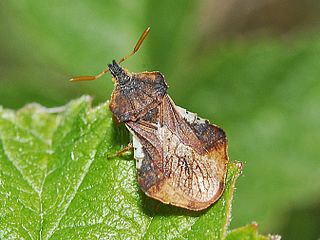
Phymata crassipes is a species of assassin and thread-legged bugs belonging to the family Reduviidae, subfamily Phymatinae.
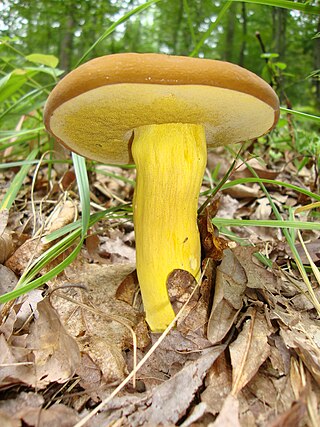
Boletus auripes, commonly known as the butter-foot bolete, is a species of bolete fungus in the family Boletaceae. First described from New York in 1898, the fungus is found in eastern Asia, Central America, and eastern North America from Canada to Florida. It is a mycorrhizal species and typically grows in association with oak and beech trees.

Boletinellus merulioides, commonly known as the ash-tree bolete, is a species of bolete fungus in the family Boletinellaceae. Described as new to science in 1832, it is found in Asia and eastern North America, where it grows on the ground near ash trees.
Madhuca crassipes is a plant in the family Sapotaceae. The specific epithet crassipes means "thick foot or stalk", referring to the fruit stalk.
Gyrodon miretipes is a bolete mushroom described in 1983 from Burundi. it has a red-brown cap and stipe, and yellow-tan decurrent gills.
Gyrodon ripicola is a bolete fungus in the family Paxillaceae. Found in Singapore, the species was first described in 1971 by E.J.H. Corner as a species of Paxillus. Pegler and Young transferred it to the genus Gyrodon in 1981.
Gyrodon intermedius is a bolete fungus in the family Paxillaceae native to Africa, where it has been recorded from Congo, Liberia and Madagascar.
Cornops aquaticum is a semiaquatic species of grasshopper native to the Neotropics, from southern Mexico south to central Argentina and Uruguay. It feeds and breeds exclusively on members of the aquatic plant family Pontederiaceae, especially water hyacinth, and is being investigated as a possible biological pest control agent for the water hyacinth in countries where that plant is invasive.

Boletinellus monticola, previously known as Gryodon monticola, is a bolete fungus in the Boletinellaceae family with a pored hymenium rather than gills. This species can be identified by its common ectomycorrhizal association and therefore close proximity to Alder trees. B. monticola is most commonly found near the equator, specifically in Southern Mexico and stretching into northern South America.













